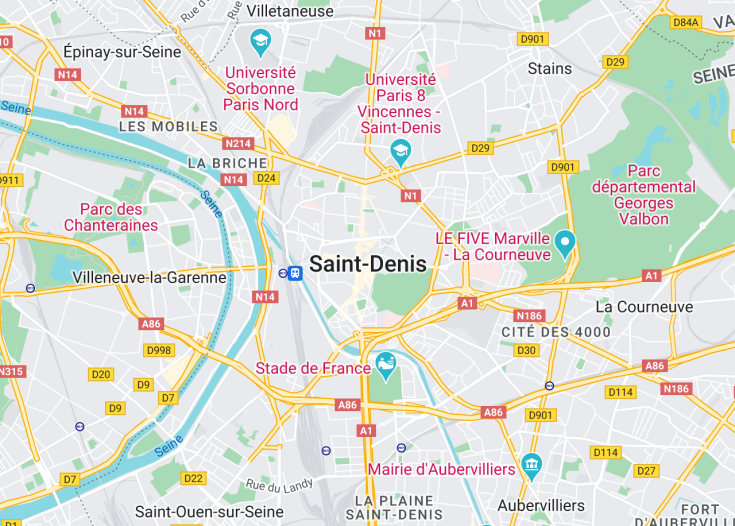Saint-Denis, a city rich in historical and cultural heritage located just north of Paris, France, offers an enchanting escape steeped in centuries of history. This vibrant locale is famed for the Basilica of Saint-Denis, a monumental masterpiece of Gothic architecture and the final resting place of French royalty. The city is a tapestry of diverse influences, showcasing splendid parks, a dynamic arts scene, and bustling markets that reflect its contemporary energy while embracing its storied past.
Before visiting Saint-Denis, ensure to check the schedule for guided tours available at Saint-Denis Basilica to fully appreciate its architectural magnificence and historical significance.
Plan your visit to coincide with the local market days to experience the vibrant community atmosphere and sample regional specialties direct from local producers.
Top things to do & see in Saint-Denis
Select the following sights and activities to discover best tickets and tours available in Saint-Denis.
Saint-Denis: A Fusion of History and Modernity
| Country | France |
| Time in Saint-Denis | GMT+1 |
| Language spoken | French |
| Population | 111,354 (source: INSEE 2022) |
| Currency | Euro (€, EUR) |
| Airports |
|
Saint-Denis, a city steeped in history and bustling with modern life, is located just north of Paris, France. This vibrant commune has evolved markedly from its origins but retains a rich historical core that coexists with its contemporary persona. Historically known for the Basilica of Saint-Denis, a burial site for French royalty, the city today is more than just a silent keeper of the past; it plays a vital role in Paris’ metropolitan and cultural landscape.
Where is Saint-Denis?
Saint-Denis is situated in the northern suburbs of Paris, just 9 kilometers northeast of the city center.
Distances:
| Route | Distance by car | Time by car |
|---|---|---|
| Paris to Saint-Denis | 9 km | 20 min |
| Versailles to Saint-Denis | 24 km | 35 min |
| Orly to Saint-Denis | 28 km | 40 min |
What is Saint-Denis famous for?
Notably, Saint-Denis is famous for the Saint-Denis Basilica, the first Gothic church and burial site of French kings. It’s also known for its vibrant market, one of the largest and most colorful in the Paris metropolitan area.
History
Before the 7th Century: Early Settlements
Archaeological findings suggest that the area around what is now Saint-Denis was inhabited by small, scattered tribes during the prehistoric era, with some evidence pointing to activity as far back as the Neolithic period. The fertile lands along the Seine provided ample resources for hunter-gatherer societies.
7th Century – 10th Century: The Birth of a Sanctuary
The transformation of Saint-Denis began with the establishment of a small chapel in the 7th century, where Saint Denis, the patron saint of France, was believed to have been buried. By the 8th century, this chapel had been replaced by a larger church, attracting pilgrims and contributing to the area’s growth.
10th Century – 18th Century: Rise of Monarchical Symbolism
Dominating the medieval period was the construction of the Basilica of Saint-Denis, finalized in the 12th century. It became the first Gothic church and was pivotal in the development of Gothic architecture. The basilica also served as the burial ground for French monarchs, enhancing its status as a site of national importance.
19th Century: Industrial Expansion and Urbanization
During the Industrial Revolution, Saint-Denis experienced significant growth. The establishment of railroads and factories in the 19th century transformed it into a major industrial hub. The city’s population grew, as did its infrastructure, with the construction of roads, schools, and other public buildings.
20th Century – Present: Challenges and Revitalization
The latter part of the 20th century brought economic challenges, with the decline of traditional industries. However, recent decades have seen efforts to revitalize Saint-Denis, including the development of the Stade de France for the 1998 World Cup. Contemporary Saint-Denis is marked by its multicultural population and its blend of historic and modern urban landscapes.
Visit Saint-Denis
What to see and do in Saint-Denis, France
Visitors to Saint-Denis should not miss the Basilica of Saint-Denis, a masterpiece of Gothic architecture and the final resting place of French royalty. Exploring the local markets and diverse neighborhoods offers a taste of the city’s rich cultural tapestry. For sports enthusiasts, a tour of the Stade de France is a must.
- Basilica of Saint-Denis tours
- Stade de France visits
- Local markets and culinary discoveries
Annual Events in Saint-Denis
Saint-Denis hosts several cultural and sports events throughout the year. The Fête de la Musique in June celebrates music with free performances across the city. Additionally, the Saint-Denis Festival, held in spring, features classical music concerts in historic venues.
Best time to visit Saint-Denis
The best times to visit Saint-Denis are spring and fall, when the weather is mild and the city’s events are in full swing. The pleasant climate during these seasons makes it ideal for exploring both the historical sites and modern attractions.
Is Saint-Denis worth visiting?
Saint-Denis offers a unique blend of historical richness and contemporary culture, making it a worthwhile visit. The city’s highlights, like the Basilica of Saint-Denis, provide insights into France’s royal history, while its diverse communities offer a vibrant atmosphere. However, visitors should be aware of the socio-economic challenges and the contrasting modern urban conditions. Overall, Saint-Denis presents an intriguing, multifaceted experience that can enrich one’s understanding of French heritage and modern dynamics.









